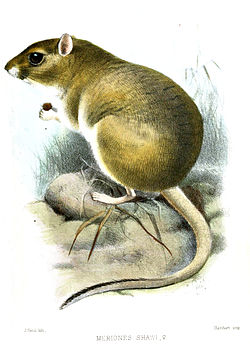| Shaw's jird | |
|---|---|
 | |
 | |
| Scientific classification | |
| Kingdom: | Animalia |
| Phylum: | Chordata |
| Class: | Mammalia |
| Order: | Rodentia |
| Family: | Muridae |
| Genus: | Meriones |
| Species: | M. shawi |
| Binomial name | |
| Meriones shawi (Duvernoy, 1842) | |
Shaw's jird (Meriones shawi) is a species of rodent in the family Muridae. It is found in Algeria, Egypt, Libya, Morocco, and Tunisia. Its natural habitats are arable land, pastureland, and rural gardens.
Shaw's jird is able to survive long periods of dehydration in semi-desert regions where it lives, in part because of its well developed kidneys. [2] Shaw's jird can mate 224 times in two hours. [3] During the rainy season, Shaw's jirds breed more compared to summer when there is less rain. [4] They typically live 1–2 years. [1] In the Algerian highlands, they are a main prey source for Barn owls. [5]
